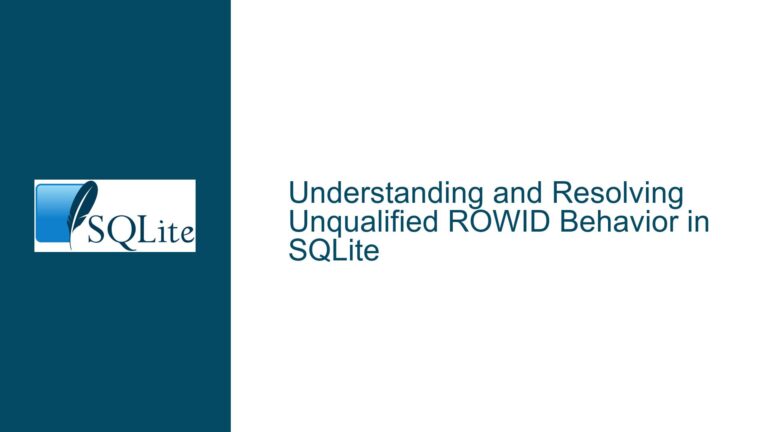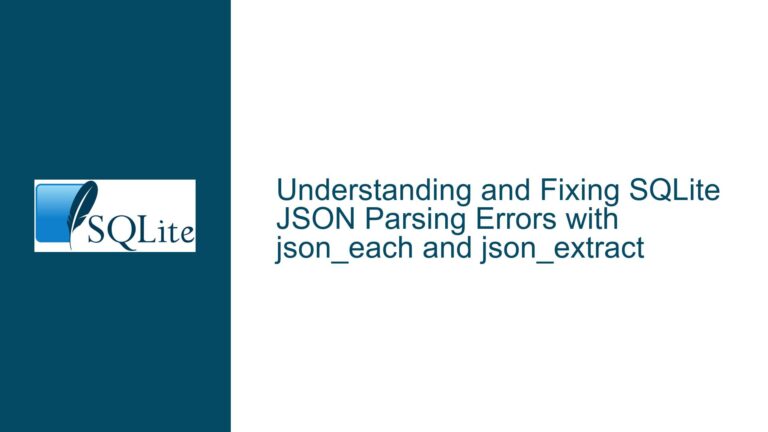RETURNING rowid from Virtual Table INSERT in SQLite: Issue and Fixes
Understanding the Behavior of RETURNING rowid in Virtual Table INSERTs
When working with SQLite virtual tables, one of the most common tasks is inserting data and retrieving the automatically generated rowid. The rowid is a unique identifier for each row in a table, and it is often used for efficient lookups and updates. However, a peculiar issue arises when attempting to retrieve the rowid immediately after an INSERT operation using the RETURNING clause. Specifically, the RETURNING clause returns -1 instead of the actual rowid, even though the rowid is correctly assigned and can be retrieved using the last_insert_rowid() function.
This behavior is not limited to custom virtual table modules but is also observed in built-in virtual tables like FTS5. For example, when inserting a row into an FTS5 virtual table and using the RETURNING clause to fetch the rowid, the returned value is -1. However, a subsequent call to last_insert_rowid() correctly returns the assigned rowid. This discrepancy raises questions about the expected behavior of the RETURNING clause in the context of virtual tables and whether it is possible to retrieve the rowid directly from the INSERT statement.
To fully understand this issue, it is essential to delve into the mechanics of virtual tables in SQLite, the role of the xUpdate function in assigning rowids, and the interaction between the RETURNING clause and virtual table implementations. This analysis will explore the possible causes of this behavior and provide detailed troubleshooting steps and solutions to address the issue.
The Role of xUpdate in Assigning rowid and RETURNING Clause Behavior
The core of the issue lies in the interaction between the xUpdate function of a virtual table module and the RETURNING clause in SQLite. The xUpdate function is responsible for handling INSERT, UPDATE, and DELETE operations on a virtual table. When a new row is inserted into a virtual table, the xUpdate function is called, and it is expected to assign a rowid to the new row by setting the value of *pRowid. This rowid is then used by SQLite to uniquely identify the row within the virtual table.
However, the RETURNING clause, which is designed to return the values of specified columns (including rowid) immediately after an INSERT operation, does not seem to work as expected with virtual tables. Instead of returning the assigned rowid, it returns -1. This behavior suggests that the RETURNING clause is not able to access the rowid assigned by the xUpdate function at the time of the INSERT operation.
One possible explanation for this behavior is that the RETURNING clause is executed before the xUpdate function has completed its task of assigning the rowid. In other words, the RETURNING clause may be attempting to retrieve the rowid before it has been set by the xUpdate function, resulting in the default value of -1. This timing issue could be due to the way SQLite handles virtual table operations internally, where the rowid assignment and the RETURNING clause execution are not synchronized.
Another possibility is that the RETURNING clause is not fully supported for virtual tables, or that its behavior is different from regular tables due to the unique nature of virtual table implementations. Virtual tables often rely on custom code to manage data storage and retrieval, which may not fully align with the standard behavior of SQLite’s RETURNING clause. This misalignment could lead to the observed discrepancy between the RETURNING clause and the last_insert_rowid() function.
Resolving the RETURNING rowid Issue in Virtual Table INSERTs
To address the issue of retrieving the rowid from a virtual table INSERT operation using the RETURNING clause, several approaches can be considered. These approaches range from modifying the virtual table implementation to using alternative methods for retrieving the rowid.
One potential solution is to ensure that the xUpdate function assigns the rowid before the RETURNING clause is executed. This could be achieved by adding a synchronization mechanism within the virtual table module to guarantee that the rowid is set before the RETURNING clause attempts to retrieve it. However, this approach may require significant changes to the virtual table implementation and could introduce additional complexity.
Another approach is to avoid using the RETURNING clause altogether and instead rely on the last_insert_rowid() function to retrieve the rowid after the INSERT operation. This method is straightforward and does not require any changes to the virtual table implementation. However, it does require an additional query to fetch the rowid, which may not be ideal in all scenarios.
For those who prefer to use the RETURNING clause, an alternative is to create a custom function within the virtual table module that explicitly returns the rowid after an INSERT operation. This function could be called in place of the RETURNING clause and would ensure that the correct rowid is returned. This approach provides a more integrated solution but requires additional coding and testing to ensure compatibility with the virtual table module.
In conclusion, while the RETURNING clause does not currently work as expected with virtual tables in SQLite, there are several ways to work around this limitation. By understanding the underlying causes of the issue and exploring alternative methods for retrieving the rowid, developers can effectively manage INSERT operations on virtual tables and ensure that the correct rowid is available for subsequent operations.






